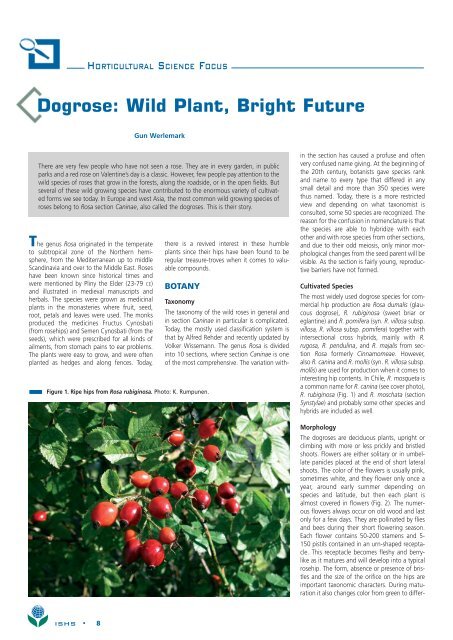Chronica Horticulturae volume 49 number 2 ... - Acta Horticulturae
Chronica Horticulturae volume 49 number 2 ... - Acta Horticulturae
Chronica Horticulturae volume 49 number 2 ... - Acta Horticulturae
Create successful ePaper yourself
Turn your PDF publications into a flip-book with our unique Google optimized e-Paper software.
HORTICULTURAL SCIENCE FOCUS<br />
Dogrose: Wild Plant, Bright Future<br />
Gun Werlemark<br />
There are very few people who have not seen a rose. They are in every garden, in public<br />
parks and a red rose on Valentine’s day is a classic. However, few people pay attention to the<br />
wild species of roses that grow in the forests, along the roadside, or in the open fields. But<br />
several of these wild growing species have contributed to the enormous variety of cultivated<br />
forms we see today. In Europe and west Asia, the most common wild growing species of<br />
roses belong to Rosa section Caninae, also called the dogroses. This is their story.<br />
The genus Rosa originated in the temperate<br />
to subtropical zone of the Northern hemisphere,<br />
from the Mediterranean up to middle<br />
Scandinavia and over to the Middle East. Roses<br />
have been known since historical times and<br />
were mentioned by Pliny the Elder (23-79 CE)<br />
and illustrated in medieval manuscripts and<br />
herbals. The species were grown as medicinal<br />
plants in the monasteries where fruit, seed,<br />
root, petals and leaves were used. The monks<br />
produced the medicines Fructus Cynosbati<br />
(from rosehips) and Semen Cynosbati (from the<br />
seeds), which were prescribed for all kinds of<br />
ailments, from stomach pains to ear problems.<br />
The plants were easy to grow, and were often<br />
planted as hedges and along fences. Today,<br />
there is a revived interest in these humble<br />
plants since their hips have been found to be<br />
regular treasure-troves when it comes to valuable<br />
compounds.<br />
BOTANY<br />
Figure 1. Ripe hips from Rosa rubiginosa. Photo: K. Rumpunen.<br />
Taxonomy<br />
The taxonomy of the wild roses in general and<br />
in section Caninae in particular is complicated.<br />
Today, the mostly used classification system is<br />
that by Alfred Rehder and recently updated by<br />
Volker Wissemann. The genus Rosa is divided<br />
into 10 sections, where section Caninae is one<br />
of the most comprehensive. The variation within<br />
the section has caused a profuse and often<br />
very confused name giving. At the beginning of<br />
the 20th century, botanists gave species rank<br />
and name to every type that differed in any<br />
small detail and more than 350 species were<br />
thus named. Today, there is a more restricted<br />
view and depending on what taxonomist is<br />
consulted, some 50 species are recognized. The<br />
reason for the confusion in nomenclature is that<br />
the species are able to hybridize with each<br />
other and with rose species from other sections,<br />
and due to their odd meiosis, only minor morphological<br />
changes from the seed parent will be<br />
visible. As the section is fairly young, reproductive<br />
barriers have not formed.<br />
Cultivated Species<br />
The most widely used dogrose species for commercial<br />
hip production are Rosa dumalis (glaucous<br />
dogrose), R. rubiginosa (sweet briar or<br />
eglantine) and R. pomifera (syn. R. villosa subsp.<br />
villosa, R. villosa subsp. pomifera) together with<br />
intersectional cross hybrids, mainly with R.<br />
rugosa, R. pendulina, and R. majalis from section<br />
Rosa formerly Cinnamomeae. However,<br />
also R. canina and R. mollis (syn. R. villosa subsp.<br />
mollis) are used for production when it comes to<br />
interesting hip contents. In Chile, R. mosqueta is<br />
a common name for R. canina (see cover photo),<br />
R. rubiginosa (Fig. 1) and R. moschata (section<br />
Synstylae) and probably some other species and<br />
hybrids are included as well.<br />
Morphology<br />
The dogroses are deciduous plants, upright or<br />
climbing with more or less prickly and bristled<br />
shoots. Flowers are either solitary or in umbellate<br />
panicles placed at the end of short lateral<br />
shoots. The color of the flowers is usually pink,<br />
sometimes white, and they flower only once a<br />
year, around early summer depending on<br />
species and latitude, but then each plant is<br />
almost covered in flowers (Fig. 2). The numerous<br />
flowers always occur on old wood and last<br />
only for a few days. They are pollinated by flies<br />
and bees during their short flowering season.<br />
Each flower contains 50-200 stamens and 5-<br />
150 pistils contained in an urn-shaped receptacle.<br />
This receptacle becomes fleshy and berrylike<br />
as it matures and will develop into a typical<br />
rosehip. The form, absence or presence of bristles<br />
and the size of the orifice on the hips are<br />
important taxonomic characters. During maturation<br />
it also changes color from green to differ-<br />
ISHS • 8
















